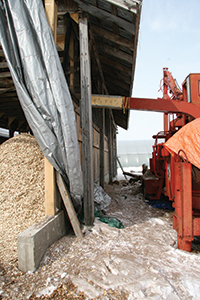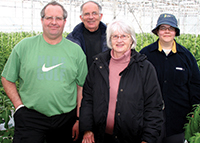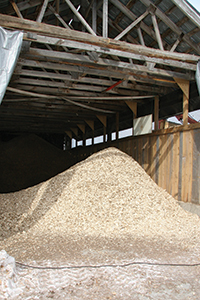
It’s not easy finding the ideal biomass heating system for a specific location and greenhouse operation.
It’s not easy finding the ideal biomass heating system for a specific location and greenhouse operation.

|
The Quebec association of greenhouse operators launched a pilot project to help members gain a better understanding of the available technologies and fuels, and what they cost.
The project was carried out on the farm of one of its members, a typical greenhouse operation.
Luc Verrier is the greenhouse owner of the farm located in St-Joachin–de-Courval, about 80 kilo-metres east of Montreal. He grows tomatoes, cucumbers and lettuce in 14 greenhouses totalling 2,500 square metres. He takes care of about 3,800 tomato plants each year (1,500 square metres), 1,500 cucumber plants (800 square metres), and 20,000 lettuce plants (200 square metres).
RETIREMENT PROJECT TURNS INTO FAMILY BUSINESS
In 1976, Verrier’s parents – Jean, a former union representative, and Pauline, who worked for a regional newspaper – bought a 50-hectare property on which they had their cottage. Six years later, the family settled there permanently.
After obtaining a college degree in horticulture in 1984, Luc built a small greenhouse beside his parents’ home. His early crops were quite challenging, in particular zucchinis and beans, but his persistence paid off with good yields and excellent quality. He soon changed his focus to tomatoes, cucumbers and lettuce, and over time scaled up his operations by adding new greenhouses. Over the years, he has built up a larger clientele and now supplies nearly 40 regional supermarkets and food stores, most of them part of the Metro and IGA chains, within a radius of 100 kilometres.
Like most businesspeople, Verrier has experienced some setbacks: a wind storm in 1985 destroyed four greenhouses, and there was a fire in the boiler room last year. (While they were waiting for firefighters, a neighbour used his heavy-duty snow blower to blanket the boiler room in snow. “Then the fire stopped and was incapable of crossing to the units just beside it,” he explained. “In a sense, we were quite lucky.”)
And what about pest control? “I prefer to prevent than to cure,” he said. “I disinfect with bleach every January, and I stop heating and let everything freeze to avoid spider mites.” He also uses predators such as Amblyseius cucumeris, Phytoseiulus persimilis and Encarsia formosa to help prevent infestations.
But despite such precautions, one greenhouse was infested with soybean aphids last fall from nearby fields. “I then installed a net to protect the entrance of this unit and I am planning to cover all the other entrances this summer.”

|
|
| Luc, Jean and Pauline Verrier, along with Isabelle Bilodeau, an agricultural technician who has worked at the farm for eight years.
|
HEATING SUCCESSFULLY WITH WILLOW AND LARCH
Before trialling the new biomass system, Verrier used two small wood furnaces and an oil furnace, along with two hot water storage tanks of 18,900 litres each. Although this is not the first greenhouse in Quebec to use a biomass system – there could be more than 20, according to pilot project advisor Jean Gobeil – this is the first to use either wood residues or willow.
“Willow takes only three years to become ready to use as biomass and is commonly used in Finland and Britain,” he said. In order to get some degree of self-sufficiency, Verrier planted 10 hectares last spring, and then 10 more at the end of April. He expects to harvest the first crops in 2013. In the meantime, he continues to use non-commercial wood supplied by area woodlot owners, which means a truckload arriving every two weeks.
He uses a second-hand chipper to further process the wood, and stores the wood chips in a shed. He plans to build two more sheds this fall to provide sufficient storage to get them through an entire year.

|
|
| The farm has plenty of fuel storage capacity.
|
PREPARING A REPORT FOR OTHER GROWERS IN THE PROVINCE
The total cost of this pilot project is expected to be about $540,000, which includes the system itself, the testing costs, and the documentation that will be available for other growers. In addition to funding from the Quebec union of greenhouse producers and Verrier, other grants were made by the Quebec Ministry of Agriculture, Fisheries and Food, which provided $213,000, and another provincial organization, l’Agence de l’éfficacité énergétique (Energy Efficiency Agency), contributed $205,000.
In operation since December 2010, it took a long time to get the system up and running satisfactorily. “We needed a system that could run with forest residues but also with willow, that required a biomass with a humidity rate of 35 per cent,” he added.
And what about the payback time?
“Not more than a year and half for a greenhouse of less than 3,000 square metres. Otherwise, the system is not profitable.”
Transfab Énergie, located in Levis, Quebec, built the heating system. “We have installed a heating system of 55 BHP (550 kW), which is enough for this location. In addition, we had to complete this system with a hot water storage unit of 34,200 litres that stores the surpluses in periods of relatively low heating and also to utilize this heat at the proper time,” said Bernard Blouin, an engineer for the manufacturer. “A 20-metric-ton silo feeder has also been built in order to ensure self-sufficiency for seven days,” he added.
STACK EMISSIONS FILTRATION ALONG WITH A DUST/ASH COLLECTOR
The control panels were set up by subcontractor Controles CEI, located in Victoriaville. The system includes a filtration system for the stack emissions, and a dust and ash collector.
According to Alain-Claude Thibeau of CIDES, one of the partners in this pilot project, the system includes a weather station made by Davis, plus an irrigation controller made by Damatex, and a temperature data logger by Onsetcomp.
Even if the system is still quite new, Verrier has already seen an improvement in temperature control, and this has meant production gains. “I harvested at least a week in advance compared to last year. The system, thanks to the sensors, controls the temperature in each unit. I am really confident that this move will be a positive experience.”
Martine Frigon is a freelance writer and photographer in Quebec.
Print this page